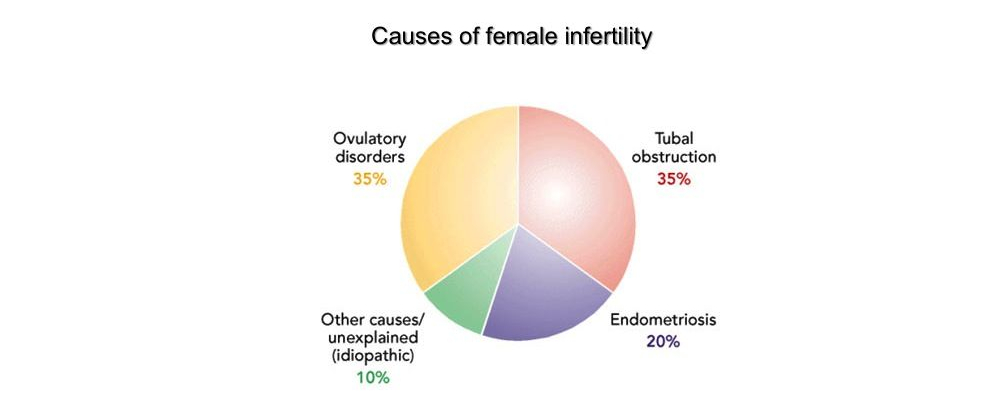FEMALE FACTORS OF INFERTILITY
Almost one third of the cause of infertility is due to female factors, any disorder which structurally or functionally affects any part of the female reproductive system may result into infertility.
In the above figure, we can see the parts of the female reproductive system which are
1)
2)
3)
4)
5)


Any condition affecting these structures individually or in combination will affect the fertility potential of the female.
The conditions affecting the ovaries are
1) Age related decline of ovarian function
Advanced age that is more than 35 years affects the ovarian reserve which affects the quality and the number of eggs.
2) Anovulation or failure to ovulate-
One of the commonest causes affecting 40% of infertile females, is the failure to ovulate due to age related decreased ovarian reserve or ovarian ageing, Disorders like PCOS and other hormone related conditions like thyroid and prolactin excess are also associated with anovulation. PCOS is one of the commonest condition affecting the ovaries wherein there is an increased androgen(male) hormone production causing irregular periods, male pattern hair growth and sonography suggestive of small cysts in the ovaries from which the condition derives its name.
3) Failure of the eggs to mature
PCOS being one of the commonest causes for failure of the eggs to mature.
4) Primary Ovarian insufficiency(POI) or Premature Ovarian Failure (POF)
Advanced age that is more than 35 years affects the ovarian reserve which affects the quality and the number of eggs.
5) Endometriosis and Chocolate cyst of ovaries
Chocolate cysts are fluid filled cysts which are filled with menstrual blood in the ovaries and are seen in 20-40% cases of endometriosis. This affects fertility potential by producing fewer and immature eggs.
6) Surgeries and trauma
Any surgeries or damage of ovarian tissue due to radiation or chemicals will decrease the ovarian reserve.
7) Infections
Mumps, a viral infection affects the ovaries.
1) Infections
Infections like Chlamydia and tuberculosis affects the fallopian tubes resulting in infertility and tubal blockages, however the tubes need not only be patent but also functionally normal for the transport of gametes. Infections may result in accumulation of fluids in the tubes called hydrosalphinx which may further get infected causing pyosalphinx.
2) Endometriosis
Endometriosis causes adhesions and further mechanically disrupts the anatomy of the tubes.
The uterus plays a key role in implantation of the embryo and maintaining the pregnancy. Uterus may be involved in various conditions hampering fertility.
1) Endometriosis and Adenomyosis
Endometriosis usually is associated with a condition of the uterus called adenomyosis. Endometriosis and adenomyosis causes defective implantation and may result in recurrent miscarriages.
2) Fibroids
Fibroids are non-cancerous growths from the muscle body of the uterus which causes infertility by various mechanisms. Almost 3 % of infertility is due to fibroids, however not all fibroids cause infertility and miscarriages, it generally depends on the location and the size of fibroids. Not all fibroids may require treatment. Those fibroids which disturb the lining of the uterus (endometrium) and those which are of huge sizes may require removal or a prompt treatment. The ways in which a fibroid would cause infertility are- changes in the shape of cavity of the uterus and cervix, interfere with blood supply of uterus and mediate local chemical changes hampering implantation of the embryo.
3) Endometritis
Endometritis is the infection of the lining of the uterus(Endometrium) which may be caused by bacteria, viruses and parasites. Tuberculosis is one of the commonest infections affecting the uterus in Indian scenarios. The course of treatment is generally antibiotics and anti-tubercular drugs in cases of tuberculosis.
4) Structural abnormalities
During the development of the uterus the two halves are fused and unified resulting in formation of a single cavity, defective or incomplete fusions may result in developmental abnormalities like septate uterus, bicornuate uterus and unicornuate uterus of which the septum requires removal and the others are associated with increased miscarriages and early labor.
5) Adhesions
Adhesions in the uterus is called Asherman’s syndrome which may be because of previous infections or other surgeries like D&C done on the uterus before.
6) Polyps
Muscular outgrowths of the lining of the uterus which may be vascular and require removal. They are non-cancerous and may be of hormonal in origin. Polyps may cause failure of implantations and hence many are tackled with hysteroscopy removal of polyps.
1) Cervical stenosis
Mechanical blockage of cervix which may cause hindrance to the spermatozoa to ascend into the cavity of the uterus.
2) Cervical mucus factors
Mainly immunological or certain cells in cervical mucus engulfing the spermatozoa’s before they can make their ways to the egg.